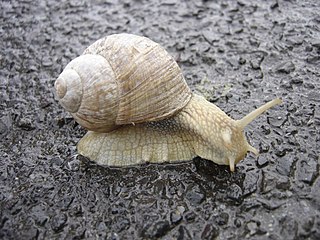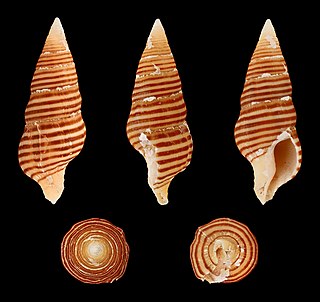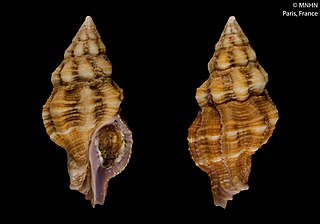
A snail is, in loose terms, a shelled gastropod. The name is most often applied to land snails, terrestrial pulmonate gastropod molluscs. However, the common name snail is also used for most of the members of the molluscan class Gastropoda that have a coiled shell that is large enough for the animal to retract completely into. When the word "snail" is used in this most general sense, it includes not just land snails but also numerous species of sea snails and freshwater snails. Gastropods that naturally lack a shell, or have only an internal shell, are mostly called slugs, and land snails that have only a very small shell are often called semi-slugs.

The gastropods, commonly known as snails and slugs, belong to a large taxonomic class of invertebrates within the phylum Mollusca called Gastropoda.

Heterobranchia, the heterobranchs, is a taxonomic clade of snails and slugs, which includes marine, aquatic and terrestrial gastropod mollusks.

The operculum is a corneous or calcareous anatomical structure like a trapdoor that exists in many groups of sea snails and freshwater snails, and also in a few groups of land snails; the structure is found in some marine and freshwater gastropods, and in a minority of terrestrial gastropods, including the families Helicinidae, Cyclophoridae, Aciculidae, Maizaniidae, Pomatiidae, etc.

Sea snail is a common name for slow-moving marine gastropod molluscs, usually with visible external shells, such as whelk or abalone. They share the taxonomic class Gastropoda with slugs, which are distinguished from snails primarily by the absence of a visible shell.

The Fasciolariidae, common name the "tulip snails and spindle snails", are a family of small to large sea snails, marine gastropod mollusks in the superfamily Buccinoidea.

Freshwater snails are gastropod mollusks which live in fresh water. There are many different families. They are found throughout the world in various habitats, ranging from ephemeral pools to the largest lakes, and from small seeps and springs to major rivers. The great majority of freshwater gastropods have a shell, with very few exceptions. Some groups of snails that live in freshwater respire using gills, whereas other groups need to reach the surface to breathe air. In addition, some are amphibious and have both gills and a lung. Most feed on algae, but many are detritivores and some are filter feeders.

Lactarius sanguifluus, commonly known as the bloody milk cap, is a species of fungus in the family Russulaceae. First described from France in 1811, the species was given its current name by Elias Fries in 1838 when he transferred it to Lactarius. Found in Asia, Mediterranean Africa, and Europe, fruit bodies (mushrooms) grow scattered or in groups on the ground under conifers, especially Douglas fir. When bruised or cut, the fruit bodies ooze a blood-red to purple latex that slowly turns greenish upon exposure to air. The caps are orangish to reddish-brown, and become funnel-shaped with age. The gills are pinkish to purplish. Different forms have been described from Italy, but these are not universally accepted as distinct. L. sanguifluus mushrooms are edible, and sold in rural markets of Europe and Asia. Fruit bodies grown in polluted soil, including roadsides subject to heavy traffic, can bioaccumulate toxic heavy metals. Several sterols and pigment have been isolated and identified from the mushrooms.

Turrilatirus craticulatus is a species of sea snail, a marine gastropod mollusk in the family Fasciolariidae, the spindle snails, the tulip snails and their allies.
Turrilatirus melvilli is a species of sea snail, a marine gastropod mollusk in the family Fasciolariidae, the spindle snails, the tulip snails and their allies.
Turrilatirus nagasakiensis is a species of sea snail, a marine gastropod mollusk in the family Fasciolariidae, the spindle snails, the tulip snails and their allies.

Turrilatirus turritus is a species of sea snail, a marine gastropod mollusk in the family Fasciolariidae, the spindle snails, the tulip snails and their allies.
Turrilatirus iris is a species of sea snail, a marine gastropod mollusk in the family Fasciolariidae, the spindle snails, the tulip snails and their allies.

Turrilatirus lautus is a species of sea snail, a marine gastropod mollusk in the family Fasciolariidae, the spindle snails, the tulip snails and their allies.
Latirulus is a genus of sea snails, marine gastropod mollusks in the family Fasciolariidae, the spindle snails, the tulip snails and their allies.

Latirus is a genus of sea snails, marine gastropod molluscs in the family Fasciolariidae, the spindle snails, the tulip snails and their allies.

Turrilatirus is a genus of sea snails, marine gastropod mollusks in the subfamily Fasciolariinae of the family Fasciolariidae, the spindle snails, the tulip snails and their allies.

In the shell of gastropod mollusks, the lip is the free margin of the peristome or aperture of the gastropod shell.

Conus is a genus of predatory sea snails, or cone snails, marine gastropod mollusks in the family Conidae. Prior to 2009, cone snail species had all traditionally been grouped into the single genus Conus. However, Conus is now more precisely defined, and there are several other accepted genera of cone snails. For a list of the currently accepted genera, see Conidae.

Terrestrial molluscs or land molluscs (mollusks) are an ecological group that includes all molluscs that live on land in contrast to freshwater and marine molluscs. They probably first occurred in the Carboniferous, arising from freshwater ones.















